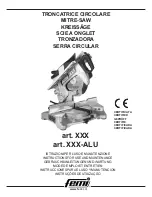
10
charger is disconnected from the power supply.
•
After normal usage, a minimum of 1 hour of
charging time is required to fully recharge
battery pack.
•
The battery pack and the charger will become
slightly warm to the touch while charging. This is
normal and does not indicate a problem.
•
Do not place the charger and battery pack in an
area of extreme heat or cold. They will work best
at normal room temperature.
NOTICE: The charger and battery pack should be
placed in a location where the temperature is
more than 32
°
F but less than 100
°
F.
•
When batteries become fully charged, unplug
the charger from power supply and remove the
battery pack.
CHARGING A HOT BATTERY PACK
When using the tool continuously, the batteries in the
battery pack will become hot. You should let a hot
battery pack cool down for approximately 30 minutes
before attempting to recharge. When the battery
pack becomes discharged and is hot, this will cause
the green LED to come on instead of the red LED.
After 30 minutes, reinsert the battery pack in the
charger. If the green LED continues to remain on,
return battery pack to your nearest Mokeneye
Authorized Service Center for checking or replacing.
NOTICE: This situation only occurs when continuous
use of the tool causes the batteries to become hot. It
does not occur under normal circumstances. Refer to
"CHARGING A COOL BATTERY PACK" for normal
recharging of batteries. If the charger does not
charge
your
battery
pack
under
normal
circumstances, return both the battery pack and
charger to your nearest Mokeneye Authorized
Service Center for electrical check.
LOCK-OFF BUTTON
See Fig. 3
Your tool is equipped with a lock-off button, located
above the variable-speed trigger switch, to prevent
the saw from being activated unintentionally.
To lock the switch in the off position, depress the lock-
off button to the (locked) position (Fig.3a).
To unlock the switch, depress the lock-off button to
the (unlocked) position (Fig.3b).
TO ATTACH/DETACH BATTERY PACK
See Fig. 4
Lock the variable-speed trigger switch "OFF" on the
tool by depressing the lock-off button to the locked
position.
To attach the battery pack:
Align the raised rib on the battery pack with the
grooves on the tool, and then slide the battery pack
onto the tool.
To detach the battery pack:
Depress the battery-release button, located on the
front of the battery pack, to release the battery pack.
Pull the battery pack out and remove it from the tool.
NOTICE: When placing the battery pack on the tool,
be sure that the raised rib on the battery pack aligns
with the groove in the tool and that the latches snap
into place properly. Improper attachment of the
battery pack can cause damage to internal
components.
Battery tools are always in
operating condition. Therefore, the
lock-off button should always be depressed and in
the locked position when the tool is not in use or
carrying at your side.
VARIABLE-SPEED TRIGGER SWITCH
See Fig. 5
Your tool is equipped with a variable-speed trigger
switch. The tool can be turned "ON" or "OFF" by
depressing or releasing the variable-speed trigger
switch.
The variable-speed trigger switch delivers higher
speed with increased trigger pressure and lower
speed with decreased trigger pressure.
LED LIGHT
See FIG. 6
Your tool is equipped with an LED, located above the
blade clamp on the tool. This LED provides additional
light on the surface of the work piece for operation in
lower-light areas.
The LED will automatically turn on with a slight
squeeze on the variable-speed trigger switch before
the tool starts running, and will turn off after the
variable-speed trigger switch is released.
BLADE SELECTION
To obtain the best performance from the saw, it is
important to select the correct blade for the
particular application and type of material to be cut.
Blades with fewer teeth, e.g., 6 teeth per inch (TPI),
are typically used for cutting wood; blades with more
teeth per inch are better for cutting metal or plastic.
We recommend 14 TPI blades for plastics and soft
metals and 18 TPI blades for hard metals.
INSTALLING AND REMOVING THE SAW
BLADE
See Fig. 7
Always lock the tool off and remove
the battery pack before making any
adjustments or assembling parts.
Depress the lock-off button to the locked position and
then remove the battery pack from the tool.
To install the saw blade:
a.
Use one hand to depress the fin on the sleeve of
the tool-less blade clamp to rotate the sleeve in
the direction of the arrow marked on the blade
Summary of Contents for RS01Z
Page 7: ...7 7a 7b 9 PIVOT SHOE 10 11...
Page 14: ......
































